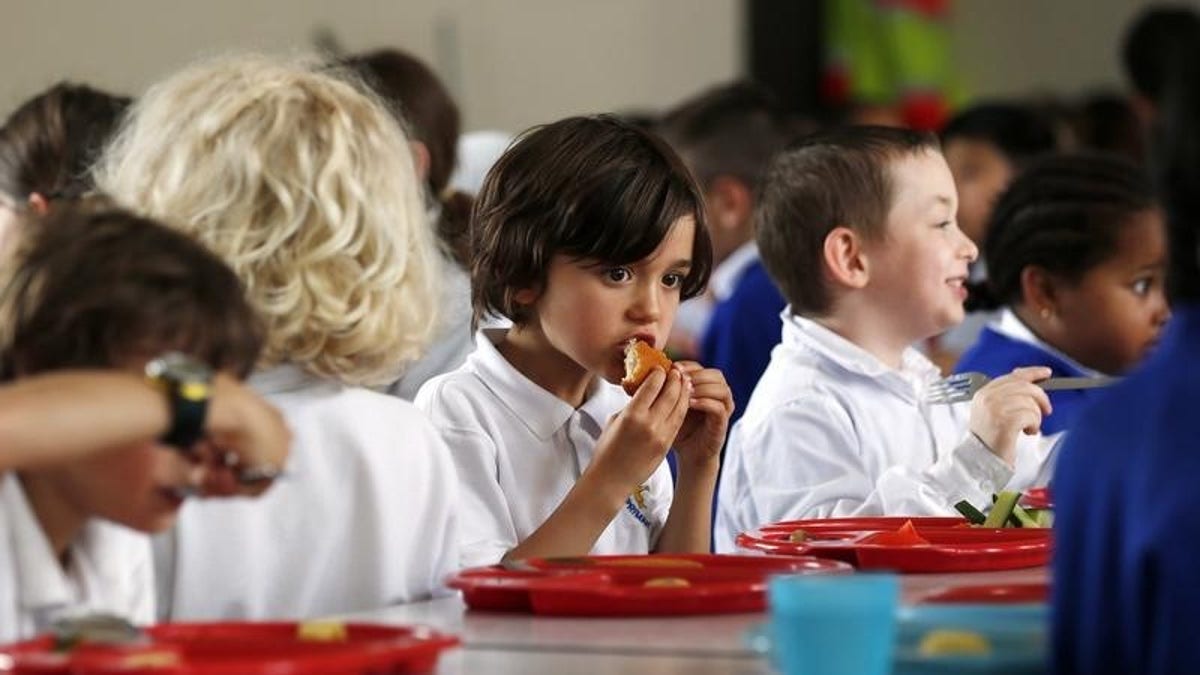
Students eat lunch at Salusbury Primary School in northwest London June 11, 2014. REUTERS/Suzanne Plunkett (Copyright Reuters 2015)
Want kids to eat more fruits and vegetables? Show them the money, a U.S. study suggests.
Researchers conducted an experiment in six Utah elementary schools, offering some kids cash and others praise for eating these healthy foods, while a third group of children got no incentives at all. Fruit and vegetable consumption was significantly higher in the group of students who got cash rewards.
Cash prizes may have helped convince kids to overcome their fear of trying new things, said study co-author Greg Madden, a psychology professor at Utah State University in Logan.
"The rewards can be used to encourage children to repeatedly try fruits and vegetables, and there is some evidence to suggest that repeatedly tasting novel foods increases their acceptability," Madden said by email.
Madden and colleagues tested the power of cash prizes at schools participating in a program called Food Dudes, which uses role modeling, repeat tasting and rewards for eating fruits and vegetables.
The study included 882 students offered prizes for eating more fruits and veggies, 640 children who were praised by teachers for doing this and a third group of 770 kids who didn't get any recognition at all based on their food choices.
At the start of the study, researchers photographed students' lunch trays before and after meals for three days to assess what they were given to eat and how much they actually consumed. During this stage, they didn't specify how many fruits or vegetables the children were served.
After that, the researchers provided all students - including kids who brought lunch from home - the same fruits and vegetables, with younger children receiving quarter-cup servings and older students getting one-third cup portions. Again, researchers took before and after pictures to see how much the children ate.
Then, researchers added rewards or praise to the children assigned to these groups over the next 16 days. To encourage tasting, students initially received bite-size portions of new fruits and vegetables, and portions were gradually increased.
All of the kids got hand stamps if they accepted the fruits and vegetables, and another hand stamp if they ate each serving. After lunch, teachers gave cash to some students with four stamps and praised others. A control group of students received the same portions of fruits and vegetables but didn't get cash or praise.
Compared with students who didn't get any incentives, students who got prizes increased their fruit and vegetable consumption by 0.32 cups, while kids who received praise consumed 0.21 cups more.
Over about three months, the kids self-reported their fruit and vegetable consumption, and teachers tracked their progress on wall charts in the classroom, while continuing to offer prizes or praise to students in those study groups.
Then, the rewards stopped. Researchers checked back with the kids six months later to see what they put on their lunch trays and what they ate and found the students in the prize group still ate significantly more fruits and vegetables than their peers.
It's possible that the delay between fruit and vegetable consumption and the delivery of any reward might have diluted the effectiveness of the incentives, the authors acknowledge in the Journal of the Academy of Nutrition and Dietetics. It's also possible that the students exaggerated how much they ate when they reported their own eating habits.
Even when the rewards work in school, however, this is only one piece of the puzzle, noted Samantha Heller, a nutritionist at New York University's Center for Musculoskeletal Care and Sports Performance who wasn't involved in the study.
"Rewarding good behavior such as healthy eating is a step in the right direction," Heller said by email.
But kids don't eat every meal at school.
"The children still need strategies for managing healthy eating choices outside the cafeteria and when the rewards stop," Heller added.
